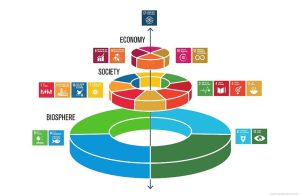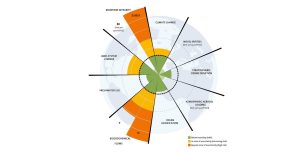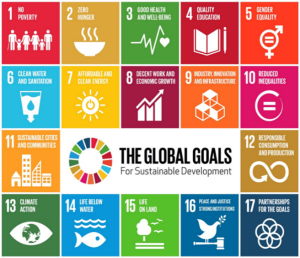I was asked to address a different topic, but sustainability seems to be of such an interest to everyone in coatings; and really just about everywhere, that I decided to take the subject on instead. As I have indicated, there is a lot being written about it so I will not address a specific topic but summarize the subject and provide links and suggestions to the reader. I have never seen such interest in a particular area in 45+ years by every company and function. The only thing that same close was Six Sigma. I provided an overview in 2022, at which time there were approximately 40 articles on sustainability on this site, and it has been covered in this forum most recently by Ron Lewarchik.
Just in the past week (last week of March) there is the European Coating Show in Nuremberg which I’m sure has sustainability as a large part of many booths and displays.
It is challenging to measure sustainability as the concept is complex, contextual, and dynamic. Indicators have been developed to cover the environment, society, or the economy however there is no fixed definition of sustainability indicators. The metrics are evolving and include indicators, benchmarks and audits. They include sustainability standards and certification systems like Fairtrade and Organic. They also involve indices and accounting systems such as corporate sustainability reporting and Triple Bottom Line accounting. Almost any large company has some kind of sustainability metrics, and if you are reading this and new to the topic I suggest that you look at corporations such as Dow Chemical, Arkema, etcetera, and the perspective as seen from a company perspective in 2018 was published by the American Coatings Association. Much of today’s issues are the same as years ago.
Global issues of sustainability are difficult to tackle as they need global solutions. Existing global organizations such as the UN and WTO are seen as inefficient in enforcing current global regulations. One reason for this is the lack of suitable sanctioning mechanisms. Governments are not the only sources of action for sustainability. For example, business groups have tried to integrate ecological concerns with economic activity, seeking sustainable business. Religious leaders have stressed the need for caring for nature and environmental stability. Individuals can also live more sustainably.
The more recent trend in sustainability is looking to reduce the carbon footprint or carbon capture, as business opportunities. There are companies that look to capitalize on tracking and sharing carbon capture and ESG reporting. Companies suggest that you share your ESG performance with your investors, clients and staff by creating an inspiring, on-brand website. Sustainability is not just an action, and companies have realized that manual report updates and redesigns every year by automatically syncing your public site with your data, allows you to see how effective your site is, and that people have read your report by tracking visitor engagement.

I have provided numerous references but perhaps the place to start should be a publication from the World Coatings Council, with contributions to the United Nations Sustainable Development Goals. That is labeled Sustainability in the Global Paint and Coatings industry. Not only does it contain information on sustainable development goals, but detailed information on the specifics to those items. What has slowly changed over time is the development of reporting directives. The corporate sustainability reporting directive embeds sustainability and assurance within the annual reporting process.
Another significant interpretation of sustainability is referenced by planetary boundaries. They are a framework that identifies critical environmental limits within which humanity can safely operate without causing significant harm to the Earth’s systems. This concept outlines nine biophysical systems that regulate the stability and resilience of the Earth system, including climate change, biodiversity loss, and land-use change. Crossing these boundaries may lead to irreversible environmental changes and disrupt the stability of the planet. Recent research has quantified these boundaries, emphasizing the need for sustainable development to ensure a safe operating space for humanity.

This article is coatings-focused, but subsegments of coating are inks, paints, adhesives and elastomers. The tendency for people to think about coatings are just paint-related, but a large need and growth area is in food packaging. The demand for paper-based packaging solutions as an alternative to incumbent single-use petroleum-based polymers for food packaging applications. Paper-based packaging enables direct options for recycling and, in the case of unintended leakage, avoids the formation of microplastics through natural biodegradation. Microplastics are at the forefront of sustainability on the negative side. Substitute of the plastic film with paper formats will reduce product shelf-stability and increase food waste.
Work smarter and win more, with powerful software to manage regulatory, supply chain and sustainability challenges, learn more about ULTRUS here!
Enzymatically polymerized microcrystalline glucan (MCG) as a functional additive in natural rubber (NR)-based coating formulation has been employed recently in food packaging development (August 2022). NR coating formulations containing 0–50 wt % MCG were fabricated at a constant coating thickness with a continuous solid content. The influence of the MCG on the wet and dry strength, rheology, adhesion strength, and barrier properties such as moisture, oxygen, and grease barrier of the formulated coatings was found to be similar to petroleum-based product. The optimized NR/MCG coating displayed promising mechanical properties as well as oxygen and oil barrier properties. Generally, the formulated NR/MCG paper coatings demonstrated excellent wet strength in conjunction with outstanding barrier properties, indicating their potential as a sustainable alternative in the food packaging industry.

Besides all of the articles that have been suggested, there are specific journals for sustainability. MDPI publishes Sustainability (ISSN 2071-1050) as an international and cross-disciplinary, scholarly, open access journal of technical, environmental, cultural, economic and social sustainability of human beings, which provides an advanced opportunity for studies related to sustainability and sustainable growth. As a peer-reviewed and semimonthly journal, Sustainability publishes reviews, regular research papers, communications, and short notes, with no restriction on the maximum length of the papers.
As a transdisciplinary journal, Sustainability encourages researchers to provide full experimental and methodological details so that results can be reproduced and assessed. The journal supports open access and open science.
The 11th World Sustainability Forum will be held October 02-03 2025 in Barcelona Spain. It is organized by MDPI journal on Sustainability.
If you still are not sure where to start or what you want to develop, UL Solutions has resources specifically on Sustainability and Environment. They can be contacted by Sustainability and Environment | UL Solutions. Their advisory services provide personalized guidance and support that help you accelerate product development, effectively manage safety, compliance and regulatory risks, enhance security and sustainability, and access new markets. UL 360 is an ESG Data Management Software system, with streamlined data collection, management, reporting and disclosure activities for enhanced ESG and sustainability efforts. Stephanie Lawson Stephanie Lawson | LinkedIn is ready to help you with the software.
Resources:
Sustainability | 2025 – Browse Issues
Sustainability: Our Goals as a Society
Part 2, The Synergy between Economic, Environmental and Social Considerations
An Update on Sustainability in the Coatings Industry — American Coatings Association
What Is Sustainability and Why Is It Important? | EnvironmentalScience.org
Paint and Coatings Raw Materials in 2021: It’s All About Resilience, Pilcher
Increased interest in sustainable coatings solutions | European Coatings (european-coatings.com)
WEBINAR: How Design and Materials Meet Needs, Sustainability Goals (ulprospector.com)
WEBINAR: Furthering Sustainability with Powder Coatings (ulprospector.com)
Webinar: New Resins from Bio-feedstock for Enhanced Sustainability (ulprospector.com)
The views, opinions and technical analyses presented here are those of the author or advertiser, and are not necessarily those of ULProspector.com or UL Solutions. The appearance of this content in the UL Prospector Knowledge Center does not constitute an endorsement by UL Solutions or its affiliates.
All content is subject to copyright and may not be reproduced without prior authorization from UL Solutions or the content author.
The content has been made available for informational and educational purposes only. While the editors of this site may verify the accuracy of its content from time to time, we assume no responsibility for errors made by the author, editorial staff or any other contributor.
UL Solutions does not make any representations or warranties with respect to the accuracy, applicability, fitness or completeness of the content. UL Solutions does not warrant the performance, effectiveness or applicability of sites listed or linked to in any content.
